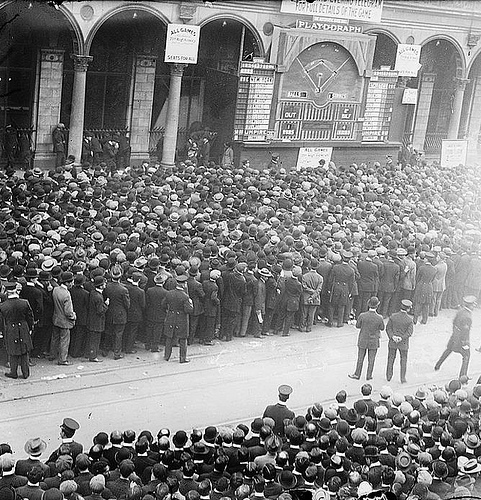Playograph on:
[Wikipedia]
[Google]
[Amazon]
 The Playograph was a machine or an electric scoreboard used to transmit the details of a
The Playograph was a machine or an electric scoreboard used to transmit the details of a
 Newspapers usually used Playograph especially when covering the World Series. One of the earliest of these was the World Series of 1911. ''
Newspapers usually used Playograph especially when covering the World Series. One of the earliest of these was the World Series of 1911. ''
Uniwatch Blog
"Playography." December 10, 2009.
Yale Sheffield Monthly
"The Automated Baseball Playograph." September 1912, pg. 195–198. Baseball mass media {{wireless-stub
 The Playograph was a machine or an electric scoreboard used to transmit the details of a
The Playograph was a machine or an electric scoreboard used to transmit the details of a baseball
Baseball is a bat-and-ball sport played between two teams of nine players each, taking turns batting and fielding. The game occurs over the course of several plays, with each play generally beginning when a player on the fielding tea ...
game in the era before television. It is approximated by the "gamecast" feature on some sports web sites: it had a reproduction of a baseball diamond
A baseball field, also called a ball field or baseball diamond, is the field upon which the game of baseball is played. The term can also be used as a metonym for a baseball park. The term sandlot is sometimes used, although this usually refers ...
, with an inning-by-inning scoreboard
A scoreboard is a large board for publicly displaying the score in a game. Most levels of sport from high school and above use at least one scoreboard for keeping score, measuring time, and displaying statistics. Scoreboards in the past used ...
, each team's lineup, and it simulated each pitch: a ball, a strike, a hit, an out, and so on.
A telegraph operator, who was watching the game live, transmitted the details of the baseball game to the two people operating the Playograph. An "X" on the diamond represented a runner; an "O" was displayed if the runner got out. A ball was moved animatronically to show fastballs or curveballs, where it was hit, and so on.
Development
The invention of the Playograph is attributed to the Connecticut-based Baseball Playograph Company, which manufactured this mechanical device as a product. Several innovations were introduced later on such as its shift from mechanical to electronic and the use of colored lights to indicate players, their position on the field, and whether the batter was safe or out. Newspapers usually used Playograph especially when covering the World Series. One of the earliest of these was the World Series of 1911. ''
Newspapers usually used Playograph especially when covering the World Series. One of the earliest of these was the World Series of 1911. ''The Scranton Times
''The Scranton Times-Tribune'' is a morning newspaper serving the Scranton, Pennsylvania, area. It is the flagship title of Times-Shamrock Communications and has been run by three generations of the Lynett-Haggerty family. On Sundays, the paper ...
'', for instance, set one up at Spruce Street side of the Times building. An account also cited an installation by '' The San Diego Sun'' and described the Playograph as "imposing in size and appearance, readable from a distance and as clear to understand as a first grader."
The Playograph also became a regular social event as people attended the display in large numbers and there are those who even paid as much as 50 cents per game to witness the live updates. It was mounted in the sides of the building, auditorium, grandstands, parking lots, opera houses, theaters, or on the street. There are even cases where operators moved it around different venues to accommodate overflowing crowds.
A similar contraption called the "Gridgraph," was used for football games. It was also produced by the Playograph Company of Stamford. The popularity of the Playograph declined after the emergence of the radio stations, which began airing the live broadcast of baseball games.
References
External links
Uniwatch Blog
"Playography." December 10, 2009.
Yale Sheffield Monthly
"The Automated Baseball Playograph." September 1912, pg. 195–198. Baseball mass media {{wireless-stub